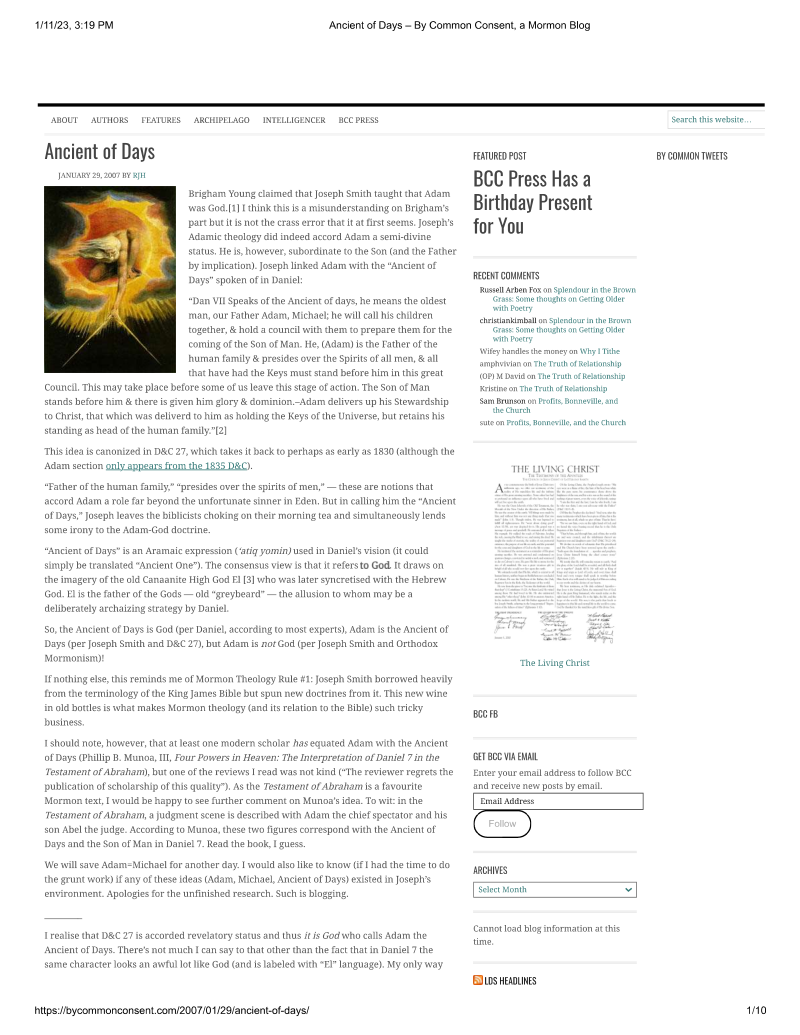Ronan J. Head discusses Joseph's identification of the "Ancient of Days" with Adam; concludes that God the Father, not Adam is the Ancient of Days of Daniel 7; instead, Joseph Smith re-appropriated the title for Adam.
- Type
- Website
- Source
- Ronan J. Head LDS
- Hearsay
- Direct
- Reference
Ronan J. Head, "Ancient of Days," By Common Consent, January 29, 2007, accessed January 11, 2023
- Scribe/Publisher
- By Common Consent
- People
- Ronan J. Head
- Audience
- Internet Public
- Transcription
Ancient of Days
Brigham Young claimed that Joseph Smith taught that Adam was God.[1] I think this is a misunderstanding on Brigham’s part but it is not the crass error that it at first seems. Joseph’s Adamic theology did indeed accord Adam a semi-divine status. He is, however, subordinate to the Son (and the Father by implication). Joseph linked Adam with the “Ancient of Days” spoken of in Daniel:
“Dan VII Speaks of the Ancient of days, he means the oldest man, our Father Adam, Michael; he will call his children together, & hold a council with them to prepare them for the coming of the Son of Man. He, (Adam) is the Father of the human family & presides over the Spirits of all men, & all that have had the Keys must stand before him in this great Council. This may take place before some of us leave this stage of action. The Son of Man stands before him & there is given him glory & dominion.–Adam delivers up his Stewardship to Christ, that which was deliverd to him as holding the Keys of the Universe, but retains his standing as head of the human family.”[2]
This idea is canonized in D&C 27, which takes it back to perhaps as early as 1830 (although the Adam section only appears from the 1835 D&C).
“Father of the human family,” “presides over the spirits of men,” — these are notions that accord Adam a role far beyond the unfortunate sinner in Eden. But in calling him the “Ancient of Days,” Joseph leaves the biblicists choking on their morning tea and simultaneously lends some irony to the Adam-God doctrine.
“Ancient of Days” is an Aramaic expression (‘atiq yomin) used in Daniel’s vision (it could simply be translated “Ancient One”). The consensus view is that it refers to God. It draws on the imagery of the old Canaanite High God El [3] who was later syncretised with the Hebrew God. El is the father of the Gods — old “greybeard” — the allusion to whom may be a deliberately archaizing strategy by Daniel.
So, the Ancient of Days is God (per Daniel, according to most experts), Adam is the Ancient of Days (per Joseph Smith and D&C 27), but Adam is not God (per Joseph Smith and Orthodox Mormonism)!
If nothing else, this reminds me of Mormon Theology Rule #1: Joseph Smith borrowed heavily from the terminology of the King James Bible but spun new doctrines from it. This new wine in old bottles is what makes Mormon theology (and its relation to the Bible) such tricky business.
I should note, however, that at least one modern scholar has equated Adam with the Ancient of Days (Phillip B. Munoa, III, Four Powers in Heaven: The Interpretation of Daniel 7 in the Testament of Abraham), but one of the reviews I read was not kind (“The reviewer regrets the publication of scholarship of this quality”). As the Testament of Abraham is a favourite Mormon text, I would be happy to see further comment on Munoa’s idea. To wit: in the Testament of Abraham, a judgment scene is described with Adam the chief spectator and his son Abel the judge. According to Munoa, these two figures correspond with the Ancient of Days and the Son of Man in Daniel 7. Read the book, I guess.
We will save Adam=Michael for another day. I would also like to know (if I had the time to do the grunt work) if any of these ideas (Adam, Michael, Ancient of Days) existed in Joseph’s environment. Apologies for the unfinished research. Such is blogging.
_________
I realise that D&C 27 is accorded revelatory status and thus it is God who calls Adam the Ancient of Days. There’s not much I can say to that other than the fact that in Daniel 7 the same character looks an awful lot like God (and is labeled with “El” language). My only way out would be to say that Adam is the ancient of days, whereas God is the Ancient of Days. Or the biblicists are wrong and the Ancient of Days is Adam. Take your choice.
The picture is William Blake’s “Ancient of Days” (aka “Urizen”) and is seen on the cover of Blake Ostler’s Exploring Mormon Thought: The Attributes of God. The Ancient of Days also appears in Philip Pulman’s anti-religion children’s saga His Dark Materials (also an upcoming movie trilogy). In the last book, God is truly ancient, but not wise and mystical; he is a bumbling and decrepit old fool.
_________
1. Buerger’s Dialogue article is a must-read.
2. 1839. WOJS 8-9.
3. Marvin Pope, El in the Ugaritic Texts
- Source Link
- https://web.archive.org/web/20100107220955/http://bycommonconsent.com/2007/01/29/ancient-of-days/
- Citations in Mormonr Qnas
The B. H. Roberts Foundation is not owned by, operated by, or affiliated with the Church of Jesus Christ of Latter-day Saints.

